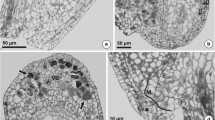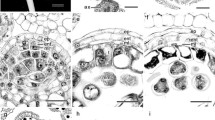Abstract
Apomixis represents an alteration of classical sexual plant reproduction to produce seeds that have essentially clonal embryos. In this report, hickory (Carya cathayensis Sarg.), which is an important oil tree, is identified as a new apomictic species. The ovary has a chamber containing one ovule that is unitegmic and orthotropous. Embryological investigations indicated that the developmental pattern of embryo sac formation is typical polygonum-type. Zygote embryos were not found during numerous histological investigations, and the embryo originated from nucellar cells. Nucellar embryo initials were found both at the micropylar and chalazal ends of the embryo sac, but the mature embryo developed only at the nucellar beak region. The mass of the nucellar embryo initial at the nucellar beak region developed into a nucellar embryo or split into two nucellar proembryos. The later development of the nucellar embryo was similar to the zygotic embryo and progressed from globular embryo to heart-shape embryo and to cotyledon embryo.
Similar content being viewed by others
Abbreviations
- AFLP:
-
amplified fragment length polymorphism
- DAP:
-
days after pollination
- FCSS:
-
flow cytometric seed screening
- SSR:
-
simple sequence repeat
References
Asadian, G., Pieber, K.: Morphological variations in walnut varieties of the Mediterranean regions. — Int. J. agr. Biol. 7: 71–73, 2005.
Asker, S.E, Jerling, L. (ed.): Apomixis in Plants. — CRC Press, Boca Raton — London 1992.
Bicknell, R.A., Koltunow, A.M.: Understanding apomixis: recent advances and remaining conundrums. — Plant Cell 16: 228–245, 2004.
Carman, J.G.: Asynchronous expression of duplicate genes in angiosperms may cause apomixis, bispory, tetraspory and polyembryony. — Biol. J. Linn. Soc. 61: 51–94, 1997.
Chen, Y., Lang, S., Gao, S., Gao, Y.: [A cytoembryological study on apomixis in walnut (Jugians regia L.).] — Acta Univ. agr. boreali-occidentalis 28: 16–20, 2000. [In Chin]
Costa, M.E., Sampaio, D.S., Paoli, A.A.S., Leite, S.C.A.L.: Polyembryony and aspects of embryogenesis in Tabebuia ochracea (chamisso) Standley (Bignoniaceae). — Rev. Bras. Bot. 27: 395–406, 2004.
Curtis, M.D., Grossniklaus, U.: Amphimixis and apomixis: two sides of the same coin. — In: Hörandl, E., Grossniklaus, U., Van Dijk, P.J., Sharbel, T. (ed.): Apomixis: Evolution, Mechanisms and Perspectives. Pp. 37–62. ARG-Gantner Ruggell, Liechtenstein 2007.
Gao, C., Chen, Y.X., Bao, Y., Feng, M., Lu, A.M.: Studies on sexual organs and embryological development morphology of Speirantha gardenii (Convallariaceae). — Chin. Bull. Bot. 45: 705–712, 2010.
Gupta, P., Shivanna, K.R., Mohan Ram, H.Y.: Apomixis and polyembryony in the guggul plant, Commiphora wightii. — Ann. Bot. 78: 67–72, 1996.
Hanna, W.W.: Use of apomixis in cultivar development. — Adv. Agron. 54: 333–350, 1995.
Higashiyama, T.: The synergid cell: attractor and acceptor of the pollen tube for double fertilization. — J. Plant Res. 115: 148–160, 2002.
Higashiyama, T., Yabe, S., Sasaki, N., Nishimura, Y., Miyagishima, S.Y., Kuroiwa, H., Kuroiwa, T,: Pollen tube attraction by the synergid cell. — Science 293: 1441–1442, 2001.
Horn, C.L.: Existence of only one variety of cultivated mangosteen explained by asexually formed ’seed’. — Science 92: 237–238, 1940.
Huang, Y., Xia, G., Wang, Z., Zheng, B., Liang, J., Huang, J.: [Studies on anatomy of development of female flower in Carya cathayensis Sarg.] — Acta agr. Univ. Jiangxi. 29: 723–725, 2007. [In Chin.]
Huang, Y.J., Wang, Z.J., Zheng, B.S., Huang, X.M., Huang, J.Q.: [Anatomy of stamen development on Carya cathayensis.] — J. Zhejiang Forest. Coll. 23: 56–60, 2006. [In Chin.]
Koltunow, A.M.: Apomixis: embryo sacs and embryos formed without meiosis or fertilization in ovules. — Plant Cell 5: 1425–1437, 1993.
Koltunow, A.M., Bicknell, R.A., Chaudhury, A.M.: Apomixis: molecular strategies for the generation of genetically identical seeds without fertization. — Plant Physiol. 108: 1345–1352, 1995a.
Koltunow, A.M., Soltys, K., Nito, N., McClure. S.: Anther, ovual, seed and nucellar embryo development in Citrus sinensis cv. Valencia. — Can. J. Bot. 73: 1567–1582, 1995b.
Lakshmanan, K.K., Ambegaokar, K.K.: Polyembryony. — In: Johri, B.M. (ed.) Embryology of Angiosperms. Pp. 445–474. Springer-Verlag, Berlin 1984.
Li, Z.: [Cultivation and Production of Hickory.] — China Agricultural Science and Technology Publishing House, Beijing. 2003. [In Chin.]
Lin, X., Yuan, X., Lin, R., Lou, Y., Fang, W.: [Megasporogenesis and female gametophytes development of Phyllostachys violascens.] — Sci. Silva. sin. 151: 55–57, 2010. [In Chin.]
Loiko, R.E.: Apomixis of walnut. — Acta Hort. 284: 233–236. 1990.
Luza, J.G., Polito, V.S.: Porogamy and chalazogamy in walnut (Juglans regia L.), — Bot. Gaz. 152: 100–106, 1991.
McKey, J.W.: Embryology of pecan. — J. agr. Res. 74: 263–283, 1947.
Miles, J.W.: Apomixis for cultivar development in tropical forage grasses. — Crop Sci. 47: 239–249, 2007.
Mo, R., Luo, Y.H., Zhou, S.M., Liu, J.P.: [Polyembryony in mango (Mangifera indica L.) and genetic analysis.] — J. trop. subtrop. Bot. 6: 475–479, 2005. [In Chin.]
Mogie, M. (ed.): The Evolution of Asexual Reproduction in Plants. — Chapman and Hall, London 1992.
Peggy, O.: Apomixis: development characteristics and genetics. — Plant Sci. 25: 199–214, 2006.
Richards, A.J.: Apomixis in flowering plants: an overview. — Phil. Trans. roy. Soc. London B 358: 1085–1093, 2003.
San, B., Dumanoğlu, H.: Determination of the apomictic fruit set ratio in some Turkish walnut (Juglans regia L.) genotypes. — Turk. J. Agr. Forest. 30:189–193, 2006.
Sartorius, R., Stösser, R.: Apomictic seed development in walnut (Juglans regia). — Angew. Bot. 65: 205–218, 1991.
Sartorius, R., Stösser, R.: On the apomictic seed development in the walnut (Juglans regia L.). — Acta Hort. 442: 225–229, 1997.
Savidan. Y.: Apomixis: genetics and breeding. — Plant Breed. Rev. 18: 13–85, 2000.
Schanderl, H.: Untersuchungen über die Blütenbiologie und Embryonenbildung von Juglans regia L. — Biol. Zlbl. 83: 71–103, 1964.
Terziiski, D., Stefanova, A.: Nature of apomixis in some Bulgarian varieties of walnut (Juglans regia L.). — Rast. Nauk. 27: 73–77, 1990.
Valdiviesso, T.: Apomixis in Portuguese walnut varieties. — Acta Hort. 284: 279–283, 1990.
Vinkenoog, R., Bushell, C., Spielman, M., Adams, S., Dickinson, H.G., Scott, R.J.: Genomic imprinting and endosperm development in flowering plants. — Mol. Biotechnol. 25: 149–184, 2003.
Wakana, A., Uemoto, S.: Adventive embryogenesis in Citrus. I. The occurrence of adventive embryos without pollination or fertilization. — Amer. J. Bot. 74: 517–530, 1987.
Wakana, A., Uemoto, S.: Adventive embryogenesis in Citrus (Rutaceae). II. Postfertilization development. — Amer. J. Bot. 75: 1031–1047, 1988.
Wang, Z., Zhang, B., Xia, G., Huang, Y., Hong, D., Huang, J.: [Analysis of progeny of Carya cathayensis × C. illinoensis and the xenia effect.] — J. Fruit Sci. 27: 908–913, 2010. [In Chin.]
Winkler, H.: Über Parthenogenesis und Apogamie im Pflanzenreiche. — Progr. Rei. Bot. 2: 293–454, 1908.
Wu, G.L., Chen, Y.H., Zhang, P.F., Yang, J.Q.: Apomixis and new selections of walnut. — Acta Hort. 760: 541–548, 2006.
Author information
Authors and Affiliations
Corresponding author
Additional information
Acknowledgments: This study was supported by the National Natural Science Foundation of China (30872047, 31170584 and 31100229), the Zhejiang Provincial Natural Science Foundation (z307534 and Y3110311).
These authors contributed equally to this work.
Rights and permissions
About this article
Cite this article
Zhang, B., Wang, Z.J., Jin, S.H. et al. A pattern of unique embryogenesis occurring via apomixis in Carya cathayensis . Biol Plant 56, 620–627 (2012). https://doi.org/10.1007/s10535-012-0256-2
Received:
Accepted:
Published:
Issue Date:
DOI: https://doi.org/10.1007/s10535-012-0256-2




